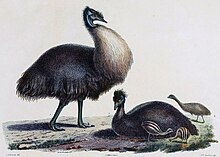Känguru-Insel-Emu
| Känguru-Insel-Emu | ||||||||||||
|---|---|---|---|---|---|---|---|---|---|---|---|---|
 Känguru-Insel-Emu (Zeichnung in Lionel Walter Rothschilds Werk Extinct Birds (1907)) | ||||||||||||
| Systematik | ||||||||||||
| ||||||||||||
| Wissenschaftlicher Name | ||||||||||||
| Dromaius novaehollandiae baudinianus | ||||||||||||
| Parker, 1984 |
Der Känguru-Insel-Emu (Dromaius novaehollandiae baudinianus) ist eine ausgestorbene Unterart aus der Gattung der Emus (Dromaius). Der Laufvogel war ein Endemit der Känguru-Insel in South Australia. Die Art war spätestens 1836 ausgestorben.
Beschreibung
Der Känguru-Insel-Emu ist nur von wenigen historischen Beobachtungen und von Knochen und Eiresten bekannt. Die Art war noch kleiner als der auf King Island endemische Schwarze Emu (Dromaius ater). Möglicherweise hatte er eine weiße Brust.[1] Im South Australian Museum in Adelaide wurde eine Rekonstruktion eines Känguru-Insel-Emus erstellt.[2]
Lebensweise
Zur Lebensweise ist fast nichts bekannt. Es wird angenommen, dass die Art in den Wäldern im Inneren der Inseln lebte.[3] Sie hat aber offenbar auch – insbesondere abends – Strände und angrenzende Sanddünen aufgesucht, um an Stellen mit Süßwasser zu trinken. Das recht häufige Tier lebte in Gruppen.[1]
Entdeckungsgeschichte und Systematik

Der Känguru-Insel-Emu wurde erst 1984 als eigenständige Art beschrieben.[4] Heute wird der Känguru-Insel-Emu von der International Ornithological Union als Unterart des Emus (Dromaius novaehollandiae) gelistet.[5]
Aussterben
Der letzte sichere Nachweis erfolgte im Jahr 1819. Die Art war spätestens 1836 ausgestorben.[1] Nicolas Baudin brachte von seiner Expedition von 1800 bis 1804 drei Tiere nach Frankreich mit, von denen eines in Paris bis ins Jahr 1822 lebte.[1]
Die Angaben zu möglichen Aussterbeursachen sind widersprüchlich. Das Department of Sustainability, Environment, Water, Population and Communities in Canberra gibt Vermutungen wieder, nach denen das Aussterben vor allem durch wiederholte Brandrodungen zur Umwandlung von Wald- und Buschland in Weideland verursacht worden sein könnte; die Jagd hat nach den dort zitierten Quellen nur eine geringe Rückgangsursache gespielt.[1] Laut IUCN war die Jagd jedoch die Hauptursache des Aussterbens; der IUCN zufolge hat ein Siedler die Art auf der Insel systematisch ausgerottet.[6]
1906 besuchte der australische Zoologe James Andrew Kershaw (1866–1946) die Känguru-Insel, wo er mehrere Emu-Knochen fand.[7]
Siehe auch
Literatur
- BirdLife International (Hrsg.): Kangaroo Island Emu – BirdLife Species Factsheet. 2008 (Online-Version).
- Chris Baxter: An Annotated List of the Birds of Kangaroo Island. Hrsg.: South Australia National Parks and Wildlife Service. Überarbeitete Auflage. 1995, ISBN 0-7308-0677-4.
- Dromaius baudinianus in der Roten Liste gefährdeter Arten der IUCN 2010. Eingestellt von: BirdLife International, 2008. Abgerufen am 4. April 2011.
Weblinks
- Artenprofil auf der Website des australischen Department of Sustainability, Environment, Water, Population and Communities
- Artenprofil auf The Extinction Website
Einzelnachweise
- ↑ a b c d e Species Profile and Threats Database. In: Department of Sustainability, Environment, Water, Population and Communities. Abgerufen am 4. April 2011 (englisch).
- ↑ Paul F. Lawson: A reconstruction of the Kangaroo Island Emu (Dromaius diemenianus). In: Records of the South Australian Museum. Volume 9, 1950, S. 309–312.
- ↑ BirdLife International: Kangaroo Island Emu - BirdLife Species Factsheet. 2008, abgerufen am 4. April 2011 (englisch).
- ↑ Shane A. Parker: The extinct Kangaroo Island emu, a hitherto unrecognised species. In: Bulletin of the British Ornithologists’ Club. Nr. 104, 1984, S. 19–22.
- ↑ IOC World Bird List: Ratites: Ostriches to Tinamous
- ↑ Dromaius baudinianus in der Roten Liste gefährdeter Arten der IUCN 2010. Eingestellt von: BirdLife International, 2008. Abgerufen am 7. April 2011.
- ↑ W. B. Spencer, J. A. Kershaw: A Collection of sub-fossil birds and marsupial remains from King Island, Bass Straits. Memoirs of the National Museum of Melbourne. 3, 1906: S. 5–35.
Auf dieser Seite verwendete Medien
Restoration of an extinct emu based on a specimen in the Museum of Natural History in Paris, now thought to belong to Dromaius ater from King Island. However, in Rothschild's book, it is used to illustrate Dromaius peroni (which is now a synonym of Dromaius baudinianus), coined for the species from Kangaroo Island he thought the specimen belonged to.
"Black Emus of Kangaroo Island".
The large bird is thought to be based on a Kangaroo Island emu, and the small one on the King Island emu, but were thought to be a male and female of the same species at the time.[1]
The original hand coloured copper engraving was engraved by F. Lambert after paintings and drawings by Charles-Alexandre Lesueur who was the offical artist of natural history on the Nicholas Baudin Voyage 1800-1804 for 'Péron, François (1775-1810).
Voyage de découvertes aux terres Australes ..., sur les corvettes le Géographe, le Naturaliste, et al goëlette la Casuarina, pendant les années 1800, 1801, 1802, 1803 et 1804. Paris: De L'Imprimerie impériale, 1807-16.
